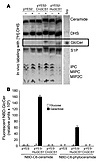Citations to this article
Citation Information: J Clin Invest. 2006;116(6):1651-1659. https://doi.org/10.1172/JCI27890.
Abstract
The pathogenic fungus Cryptococcus neoformans infects humans upon inhalation and causes the most common fungal meningoencephalitis in immunocompromised subjects worldwide. In the host, C. neoformans is found both intracellularly and extracellularly, but how these two components contribute to the development of the disease is largely unknown. Here we show that the glycosphingolipid glucosylceramide (GlcCer), which is present in C. neoformans, was essential for fungal growth in host extracellular environments, such as in alveolar spaces and in the bloodstream, which are characterized by a neutral/alkaline pH, but not in the host intracellular environment, such as in the phagolysosome of macrophages, which is characteristically acidic. Indeed, a C. neoformans mutant strain lacking GlcCer did not grow in vitro at a neutral/alkaline pH, yet it had no growth defect at an acidic pH. The mechanism by which GlcCer regulates alkali tolerance was by allowing the transition of C. neoformans through the cell cycle. This study establishes C. neoformans GlcCer as a key virulence factor of cryptococcal pathogenicity, with important implications for future development of new antifungal strategies.
Authors
Philipp C. Rittershaus, Talar B. Kechichian, Jeremy C. Allegood, Alfred H. Merrill, Mirko Hennig, Chiara Luberto, Maurizio Del Poeta
Total citations by year

Citations to this article in year 2017 (5)
| Title and authors | Publication | Year |
|---|---|---|
|
Glucosylceramide transferase in Giardia preferentially catalyzes the synthesis of galactosylceramide during encystation
L Robles-Martinez, TL Mendez, J Apodaca, S Das |
Molecular and Biochemical Parasitology | 2017 |
|
Psd1 Effects on Candida albicans Planktonic Cells and Biofilms
S Gonçalves, PM Silva, MR Felício, LN de Medeiros, E Kurtenbach, NC Santos |
Frontiers in Cellular and Infection Microbiology | 2017 |
|
Fungal Glucosylceramide-Specific Camelid Single Domain Antibodies Are Characterized by Broad Spectrum Antifungal Activity
BD Coninck, P Verheesen, CM Vos, IV Daele, MF de Bolle, JV Vieira, M Peferoen, BP Cammue, K Thevissen |
Frontiers in microbiology | 2017 |
|
Changes in glucosylceramide structure affect virulence and membrane biophysical properties of Cryptococcus neoformans
S Raj, S Nazemidashtarjandi, J Kim, L Joffe, X Zhang, A Singh, V Mor, D Desmarini, J Djordjevic, DP Raleigh, ML Rodrigues, E London, MD Poeta, AM Farnoud |
Biochimica et Biophysica Acta (BBA) - Biomembranes | 2017 |
|
Analysis of sphingolipids, sterols, and phospholipids in human pathogenic Cryptococcus strains
A Singh, A MacKenzie, G Girnun, MD Poeta |
Journal of lipid research | 2017 |



Copyright © 2025 American Society for Clinical Investigation
ISSN: 0021-9738 (print), 1558-8238 (online)

